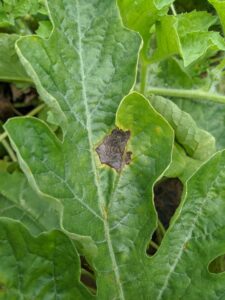3Gummy stem blight is an important disease of cucurbits in the Midwest. Gummy stem blight can cause lesions on leaves and stems of cantaloupe, watermelon and other cucurbits. Fruit lesions may be observed on pumpkin and, occasionally, on cantaloupe. Fruit lesions are known as black rot. Find more information about gummy stem blight and black rot here.
Management of gummy stem blight includes crop rotation, fall tillage and sanitation in the transplant greenhouse. However, most growers use foliar fungicides to help manage gummy stem blight. Fungicides that are labeled for use on cucurbits for gummy stem blight include contact fungicides with the active ingredient chlorothalonil and mancozeb. Systemic fungicides that are labeled for use on gummy stem blight include those found in the table below.

Systemic fungicide for control of gummy stem blight, seen above, should be alternated between FRAC Codes.
| Fungicide | REI/PHI* | FRAC code** |
| Inspire Super® | 12/7 | 3, 9 |
| Monsoon®, Onset®, Toledo®, Vibe® | 12/7 | 3 |
| Luna Experience® | 12/7 | 7, 3 |
| Miravis Prime® | 12/1 | 7, 12 |
| Quadris Top® | 12/1 | 11, 3 |
| Switch 62.5 WG® | 12/1 | 9, 12 |
*Re-Entry period in hours/Pre-Harvest period in days
**FRAC code indicates the mode of action of the fungicide.
Recently, Dr. Anthony Keinath of Clemson University reported observing isolates of the gummy stem blight fungus that are resistant to fungicides with active ingredients in FRAC group 3 in South Carolina. That is, Dr. Keinath found isolates of the gummy stem bight fungus in South Carolina that were not inhibited by fungicides in FRAC group 3 as well as isolates had been inhibited in the past. In the table above, this includes Inspire Super, Monsoon and similar products, Luna Experience, and Quadris Top. Dr. Keinath tested isolates for fungicide resistance in the laboratory and in the greenhouse.
What does this mean to Indiana cucurbit growers? Until I am able to have isolates of the gummy stem blight fungus from Indiana tested, we won’t know if we have the same problem with fungicide resistance. It is important to note that the resistance that Dr. Keinath found in the gummy stem blight fungus to fungicides with active ingredients in group 3 was not complete. That is, the resistance of the gummy stem blight isolates to group 3 fungicides observed in South Carolina is only partial. Group 3 fungicides apparently still work, just not as well. In addition, there are 3 species of the gummy stem blight and it is not clear which species has issues with fungicide resistance.
Here are my recommendations at this point.
- Don’t panic. We don’t know if we have the same fungicide issues that are present in South Carolina. And, the weather in South Carolina is much different than in Indiana.
- Always alternate fungicide modes of action (FRAC codes). It might be best to restrict use of group 3 fungicides to the first application. This makes sense because the PHI of group 3 is 7 days and therefore isn’t easy to use close to harvest.
- Always include a contact product such as chlorothalonil or mancozeb tank mixed with the group 3 fungicide.
- If you think you have issues with control of gummy stem blight with group 3 fungicides, let me know.
I will monitor the situation. If I find out more about possible fungicide resistance issues in Indiana with gummy stem blight, I will advertise the findings right here. Meanwhile, contact me if you have any questions or comments.